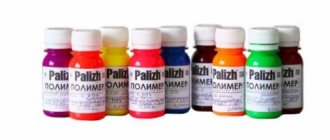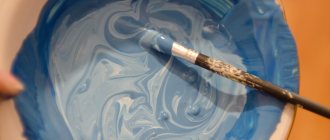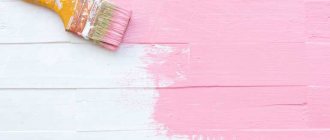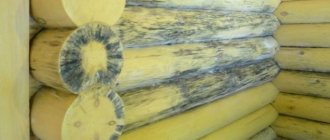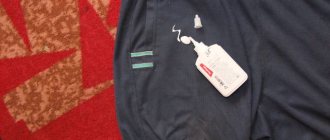Waterproofing tile joints is done to strengthen and protect the cladding. Under the influence of negative external factors, the adhesive that holds the tile in place is destroyed. This leads to deformation of the cladding.
You can avoid such consequences if you promptly protect the seam joints with a solution with waterproofing properties.
Types of sealants for waterproofing tile joints
The composition of materials characterized by hydrophobicity includes components that prevent the penetration of moisture into the cladding structure. This is due to filling the pores of the base, creating an impermeable layer. The materials are divided into 3 groups:
- cement;
- polymer;
- based on resins.
Combined mixtures are popular. They contain 2 active ingredients, for example, cement-polymer, epoxy-cement. The composition determines the properties of the material and based on this the sealant is selected. Operating conditions should be taken into account: intensity of exposure to water, air parameters (humidity, temperature).
Cement grouts
This is the most common option due to its affordable price and average characteristics. Such compositions can be found in the range of products from different manufacturers. There are single- and multi-component sealants. The first group includes mixtures that contain cement. Sand is not used.
Cement mixtures are used to fill joint joints of small width - less than 4 mm. However, when using such a material without special additives, cracks may soon appear. This is due to the fact that the cement mortar is not characterized by elasticity, which means that the coating will not withstand the effects of deformation loads (compression and tension).
In order to increase strength, a plasticizer is used; due to this component, the service life of the coating increases and the resistance to temperature changes increases.
Cement-sand mixtures are used to finish the joints between the tiles and the wall. In these areas, the width of the suture joints often exceeds 4 mm, which means that the use of pure cement mixture is not recommended.
Portland cement is popular. It is characterized by a fine-grained structure, therefore it is often used to fill narrow cracks. The composition also often includes a lime component to improve properties. Cement mortars may contain a coloring pigment, making the coating more attractive.
Silicone based fillers
Such mixtures are characterized by high elasticity. They do not deform under the influence of loads, since they tend to retain their original shape. The main component is silicone. Thanks to it, areas adjacent to plumbing fixtures in the bathroom and kitchen are sealed.
Silicone mixtures do not lose their qualities from exposure to temperature changes. However, such material cannot withstand the influence of intense loads. For this reason, they are not used to lay tiles in high-traffic areas. Due to its moisture resistance, the service life of the coating increases significantly.
Silicone mixtures tolerate the influence of extremely high and low air temperatures: -50...+200°C, without being destroyed.
Use acidic silicone-based sealants with caution. Such mixtures can contribute to the development of rust on the surface of metal elements.
A universal option is a neutral composition. However, it comes at a higher price.
A construction gun is used to work with sealants. Thanks to a nozzle with a small hole at the end, this tool helps fill joints in difficult areas, for example, near baseboards, curbs and other corner joints.
Epoxy resin based compositions
Materials in this group consist directly of epoxy resin and hardener. These components are packaged separately. They are mixed before surface treatment. This need is due to the fact that the material quickly hardens.
You need to work with it quickly - within 5 minutes the mixture begins to set. After this, it will be impractical to seal the seams with such material.
Advantages of epoxy resin:
- strength;
- elasticity;
- long service period;
- moisture resistance;
- versatility: the material can be used for various purposes, including for fastening tiles.
The solution must be removed from the coating immediately. If this is not done, the tiles will become very dirty during the repair process. It will be difficult to clean it from the epoxy mixture later.
Features of working with furan and polyurethane grouts
Furan resins are based on furfural, extracted from plant waste in agriculture and wood. To prepare a mixture with the required characteristics, it is also necessary to use a hardener, as in the case of epoxy resin. This material is a strong acid or its salt. The concentration of this component is up to 30% of the total volume of the finished mixture.
Furan resin contains coke, andesite or graphite as a filler. The hardening process takes several days if the work is carried out at room temperature. You can speed it up; to do this, you need to apply the mixture in a cold environment. When exposed to temperatures ranging from -60 to -80°C, the material will harden in a few hours.
Compared to analogues, furan resin stands out for its increased strength. Moreover, in this parameter it surpasses even epoxy resin, which is reliable in operation.
Another advantage of furan mixture is chemical resistance. This material is characterized by high adhesion to ceramics and other materials.
Furan resin can be combined with other varieties: epoxy or phenolic. This mixture has only one drawback - it is not elastic.
Polyurethane sealant, on the contrary, can withstand significant deformation loads. This is due to increased elasticity, which allows the layer of material to maintain its original shape.
This type of sealant does not need to be combined with other components. It is already ready for use. Sold in sealed plastic containers.
Polyurethane composition is recommended for filling joints with a width of 2-5 mm. It is characterized by its ability to withstand prolonged contact with water without the risk of wetting the subgrade.
Cement mixture for tile joints
The material, which is based on cement, is traditional; it is used for coating in the bathroom. This type of protection treatment is inexpensive. The cement mixture consists directly of fine cement and other additives. When water is added, the mixture becomes similar in its properties to putty.
If you need a distance between ceramics of at least 5 mm, the grout composition involves adding water. If it is necessary to process a wide seam, then sand is added to the structure, which, in turn, prevents the composition from spreading over the entire surface and holds it in the joint. If there is a large distance between the tiles, then the sand that is added to the mixture being processed should also be coarse.
Depending on your experience and preferences in the field of repair work, you can buy ready-made or dry cement grout.
The ready-made composition is easy to use, it does not need to be diluted, which means it will take less time to prepare it. However, there is one drawback to this - the finished mixture dries out quickly, you need to do everything quickly and carefully, since the entire volume of the jar must be consumed in one hour.
The second grouting option is more relevant - dry. By purchasing one jar of consistency, it becomes possible to use it for several rooms. The only difference is that the dry powder is diluted with water or latex, only in the amount necessary for the use of the room. It is important to note that the latex plasticizer will well protect the material after grouting from the development of various microorganisms. The dry mixture is very convenient for repair work, since you can take the required amount and dilute it, and this mixture can also be stored without problems.
The main advantages of cement grout:
- ease of use of dry and ready-made mixtures;
- wide choice of colors, you can choose the desired shade for the tile;
- resistance to moisture;
- wide range of use.
The disadvantage is that the service life is short. This is affected by pollution, household chemicals and detergents.
Choosing a sealant for waterproofing tile joints in a bathroom of the required quality
When considering the option of laying tiles in a bathroom, you need to protect the subfloor by filling the seams with sealant. The choice is made taking into account the requirements for materials used in rooms with high humidity:
- homogeneity of composition: uniform consistency without inclusions or large fractions;
- a sufficient degree of viscosity and elasticity, which will avoid cracking of seam joints when the material expands;
- for installation on the wall, compositions with an average strength rating are used, and for installation on the floor, the most reliable mixtures are chosen;
- water resistance, this criterion is met by most modern compositions, except for cement mixtures that absorb moisture during prolonged contact with it;
- hydrophobic properties that the material retains throughout the entire period of operation.
Pay attention to the shade of the mixture. It should fit well into the interior design.
Which grout needs protection?
Cement or epoxy?
Epoxy mixtures, unlike cement-based grouts, are not afraid of moisture, dirt, temperature changes, fungi and other dangers. But cement grout can only boast of its low cost and ease of application technology. When grouted in this way, the tile joints darken over time due to exposure to moisture and alkaline mixtures and become covered with stains and cracks.
Protection.
To ensure that the seams do not lose their original appearance, after the tiles in the bathroom are laid, you need to not only seal them well, but also be sure to cover them with special protection. Impregnations not only increase the water resistance of seams, but also prevent the formation of efflorescence, mold and mildew.
Preparation for sealing seams and joints with sealant
Work begins with preparing tools and materials:
- rubber spatula;
- container for preparing the solution;
- construction gun;
- rags, sponge;
- masking tape;
- primer mixture for surface impregnation;
- acetone for degreasing;
- respirator, gloves.
The coating is cleaned of dust. The mixture should be applied to primed surfaces. Tape tapes are glued along the seams, which will create a kind of edges that protect the tiles from contamination.
Sometimes it is necessary to renew the coating at the joints of the tiles. To do this, first remove the layer of old material[/link_webnavoz]. You should prepare a special chemical-based remover: in the form of a paste or aerosol.
Such materials are used in a ventilated area, as they often contain aggressive components. To avoid damaging the coating, it is recommended to apply the composition to a small area. The duration of action of the wash, its amount during processing - these parameters are determined by the manufacturer. It is important to prepare rubber gloves and a respirator.
Ways to update without removing grout
The easiest ways to give your decor a fresh look:
- Cleaning with detergents (universal and special household chemicals).
- Painting with paint or a special marker.
- Applying a second layer of grout.
The use of such methods will help renew the seams in the bathroom for up to six months.
With these cleaning methods, it is important not to spoil the appearance of the tiles. Do not use abrasive powders or compounds with a high acid concentration - they will make the glaze dull.
Using traditional methods based on soda and vinegar is ineffective, and in the case of acid it is also dangerous, so it is better to purchase modern products. Many of them are inexpensive and economical to use. You should not use regular soap; its residues on the surface of the seams are a favorable environment for the proliferation of microorganisms.
Before starting work, the room should be cleared of furniture if possible, ensure constant ventilation and protect the skin and respiratory organs from exposure to chemicals.
Cleaning seams with cleaning agents
If the seams between the tiles are slightly yellowed, then for cleaning it is permissible to use common surfactant-based cleaning products, such as:
- Cif;
- Pemolux;
- Comet;
- Fairy;
- Cilit et al.
For complex stains with dark, ingrained dirt, more effective chemicals will be required - these special concentrated compounds for tile joints, such as:
- Rayen;
- KiiltoClean;
- Bozo;
- HG;
- Ultra-Stripper;
- Mellerud;
- Valo Clean.
These compounds are more expensive, but they whiten better than usual household chemicals, and the packaging will last a long time.
If fungus or mold appears in the seams, disinfectants containing chlorine should be used. The most popular are regular White or Domestos.
Important! Products based on chlorine and acids are not suitable for colored grout, as they can change its shade.
How to use cleaning products:
- Apply with a sponge or brush (powdered products should first be diluted with water to form a paste).
- Gently rub the mixture, being careful not to get it on the tile area. It is convenient to use a toothbrush for this.
- Immediately remove excess product from the tiles using a rag or damp sponge.
- Leave the composition on the seams for 10-15 minutes to work.
- Rinse off any remaining product and wipe the surface dry.
When using strong chemicals, you must follow the instructions on the package. And observe personal safety measures: use goggles, gloves, and, if necessary, a respirator.
Cleaning with a steam cleaner
Renewing tile joints with steam is another simple and quick method, but it requires special equipment - a steam cleaner. The device generates steam under high pressure, effectively displaces dirt and disinfects.
It can be used both when seams are darkened by dust, and when they are affected by fungus and mold. The effect will be short-term - it will last for several months.
How to use the steam generator:
- Point the device at the seam and turn on the steam.
- Swipe along the tile several times.
- Wipe off moisture and dirt with a rag.
The main advantage of steam cleaning is that there is no need to use chemical detergents, which means cleaning becomes safe for humans.
Seam painting
Painting is an effective way to renew grout, but it will take a long time. Before applying paint, the space between the tiles must be cleaned of dirt using any method described above. The composition will not last long on dirt and mold.
Important! Painting is not suitable for restoration if the joints are filled with elastic sealant.
Applying paint will help not only update the grout in the bathroom, but also slightly change the design, since it is permissible to use compositions of any shade. If the grout was dark and the paint was light, you will have to apply several layers.
Special waterproof paints are used for painting. For example, Edding 8200 marker or Snowball pencil. These devices are easy to use, distribute the composition in an even layer, and are available with different feather thicknesses (2-4 mm) - it is selected according to the size of the seam. The marker can be white, gray or black.
Another convenient option is Fuga Fresca paint based on acrylic polymers with an application applicator and a built-in sponge that immediately removes excess paint from the tiles. The product is available in a wide range of colors.
Ordinary water-based paints are also suitable; they need to be applied with a thin brush, and can be tinted in any shade. It is acceptable to use whitewash, but for a bathroom this is an extremely short-lived option. Working with a brush is more painstaking, but such a coloring composition is inexpensive. Excess can be easily removed from the surface of the tile even after drying.
Instructions for painting tile joints:
- Clean the seams from dirt using detergents or steam.
- Dry the room well.
- Sand the grout with fine sandpaper, without touching the tiles.
- If there was mold or mildew on the surface of the seams, it is recommended to apply an antiseptic composition before painting.
- Apply paint in one layer.
- Remove excess paint from the tile surface with a damp cloth or sponge.
- Wait until completely dry, apply a second coat if necessary.
To ensure that the updated seams last as long as possible, the last layer of paint can be impregnated with a water-repellent compound, for example, Ceresit CT10, Litokol Litolast.
Applying a new layer of grout over the old one
This processing method is only suitable if the old joints are recessed by at least 1.5-2.0 mm, so that there is free space for a new layer of grout. You can choose any color for the composition, but when changing a dark shade to a light one and vice versa, the work will be more difficult, since you will need to carefully cover the entire surface without leaving gaps. For walls, it is better to choose a light color - this is a universal solution; it hides minor defects in the finish. Neutral, less easily soiled shades - gray, brown - are suitable for the floor.
Instructions for applying a new layer of grout:
- Clean the surface from dirt and dry thoroughly.
- Sand with fine-grained sandpaper. To improve adhesion, it is worth making shallow scratches on the existing grout layer with a metal spatula.
- If necessary, treat the seams with an antiseptic compound and wait until it dries.
- Fill the joints with grout using a rubber spatula, do not remove excess.
- After 15-20 minutes, remove excess grout with a dampened sponge, remove with light movements so as not to wash the grout out of the joints.
- After drying, impregnate with a water repellent.
Applying a new layer of grout over the old one is a faster method than completely replacing the compound in the joints. But the effect will be short-lived. If the adhesion between the layers of grout is weak, the top layer will quickly collapse. This also will not save you from mold; after a few months it will appear again on the surface of the seam.
Proper waterproofing of tile joints with sealant
They use a construction gun, thanks to which the seam joint becomes smoother and thinner.
After the sealant is installed in the gun, they begin to squeeze it out. Moreover, it is important to do this without interruption in order to obtain a uniform seam. Excess mixture is removed with a rubber spatula. You need to wait until the sealant has completely set. Then they begin to clean the coating from the masking tape.
Overview of methods
Sources
- https://plitkahelp.com/uhod/kak-obnovit-shvy-mezhdu-plitkoj-v-vannoj
- https://IzPlitki.com/uhod-i-remont/obnovit-shvy-mezhdu-kafelnoj-plitkoj.html
- https://rusolymp.ru/raznoe/kak-zamenit-zatirku-mezhdu-plitkami-v-vannoj
- https://MasteraVannoy.ru/plitka/kak-obnovit-shvy.html
- https://vse-postroim-sami.ru/materials/flooring-tile/8575_kak-obnovit-shvy-mezhdu-plitkoj-ochistka-pokraska-udalenie-i-zamena-zatirki/
- https://vseokafele.ru/zatirka/zamena-zatirki-shvov-plitki
- https://vanna-expert.ru/aksessuary/sovety/kak-obnovit-shvy-mezhdu-plitkoy-v-vanno.html
[collapse]
Methods for sealing the joint between the wall and plumbing
The choice of option is made taking into account the width of the gap in a given area:
- leaks are eliminated with a layer of sealant; the principle of applying the mixture is the same as on other surfaces;
- install decorative borders, they must match the interior;
- the gap is filled with mounting foam with moisture-resistant properties, then the curb is fixed, and the seams in the areas where it joins the wall and bathtub are protected with sealant;
- border tape is used, often it is made in the form of a self-adhesive strip; for fastening, the material is bent in the center and fixed on the wall and bathtub; this tape has a polyethylene base and does not get wet.
